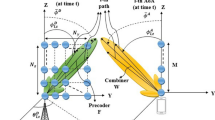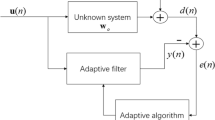Abstract
In this work, we propose a new and efficient algorithm to mitigate the signal look direction error problem in adaptive beamforming without broadening the main beam. The algorithm exploits a reference lobe in the region of signal look direction error. This reference lobe is the main beam of the generalized sidelobe canceller when there is no direction of arrival mismatch for the desired signal. The desired pattern is forced to follow the reference beam in the region of signal look direction error by utilizing multiple additional constraints. Simulations are performed in MATLAB to check and test the validity of the proposed algorithm on the basis of different scenarios.








Similar content being viewed by others
References
Khan, Z. U., Naveed, A., Qureshi, I. M., & Zaman, F. (2011). Independent null steering by decoupling complex weights. IEICE Electronics Express, 8, 1008–1013.
Sharma, V., Wajid, I., Gershman, A. B., Chen, H., & Lambotharan, S. (2008). Robust downlink beamforming using positive semi-definite covariance constraints. In IEEE international ITG workshop on smart antennas (WSA 2008) (pp. 36–41).
Byrne, D., O’Halloran, M., Jones, E., & Galvin, M. (2010). Transmitter-grouping robust capon beamforming for breast cancer detection. Progress in Electromagnetics Research, 108, 401–416.
Gerlach, K., Shackelford, A. K., & Blunt, S. D. (2007). Combined multistatic adaptive pulse compression and adaptive beamforming for shared-spectrum radar. IEEE Journal of Selected Topics in Signal Processing, 1, 137–146.
Akbar, S., Raja, M. A. Z., Zaman, F., et al. (2017). Design of bio-inspired heuristic techniques hybridized with sequential quadratic programming for joint parameters estimation of electromagnetic plane waves. Wireless Personal Communications, 96, 1475. https://doi.org/10.1007/s11277-017-4251-y.
Zaman, F. (2017). Joint angle-amplitude estimation for multiple signals with L-structured arrays using bioinspired computing. Wireless Communications and Mobile Computing, 2017, 12. https://doi.org/10.1155/2017/9428196.
Choi, Y. H. (2009). Null space projection based adaptive beamforming in the presence of array imperfections. IEICE Transactions on Communications, E92-B, 2762–2765.
Elnashar, A., Elnoubi, S. M., & El-Mikati, A. (2006). Further study on robust adaptive beamforming with optimum diagonal loading. IEEE Transactions on Antennas and Propagation, 54, 3647–3658.
Wang, W., & Wu, R. (2011). A novel diagonal loading method for robust adaptive beamforming. Progress in Electromagnetics Research C, 18, 245–255.
Du, L., Li, J., & Stoica, P. (2010). Fully automatic computation of diagonal loading levels for robust adaptive beamforming. IEEE Transactions on Aerospace and Electronic Systems, 46, 449–458.
Vorobyov, S. A., Gershman, A. B., & Luo, Z. Q. (2003). Robust adaptive beamforming using worst-case performance optimization: A solution to the signal mismatch problem. IEEE Transactions on Signal Processing, 52, 313–324.
Chen, C. Y., & Vaidyanathan, P. P. (2007). Quadratically constrained beamforming robust against direction-of arrival mismatch. IEEE Transactions on Signal Processing, 55, 4139–4150.
Li, J., & Stoica, P. (2005). Robust adaptive beamforming. New York: Wiley-Interscience.
Chang, A. C., Jen, C. W., & Su, I. J. (2007). Robust adaptive array beamforming based on independent component analysis with regularized constraints. IEICE Transactions on Communications, E90-B, 1791–1800.
Tseng, C.-Y., & Griffiths, L. J. (1992). A unified approach to the design of linear constraints in minimum variance adaptive beamformers. IEEE Transactions on Antennas and Propagation, 40(12), 1533–1542.
Griffiths, L. J., & Buckley, K. M. (1987). Quiescent pattern control in linearly constrained adaptive arrays. IEEE Transactions on Acoustics, Speech, and Signal Processing, ASSP-35, 917–926.
Arqub, O. A., et al. (2016). Numerical solutions of fuzzy differential equations using reproducing kernel Hilbert space method. Soft Computing, 20.8, 3283–3302.
Arqub, O. A., et al. (2017). Application of reproducing kernel algorithm for solving second-order, two-point fuzzy boundary value problems. Soft Computing, 21.23, 7191–7206.
Arqub, O. A. (2017). Adaptation of reproducing kernel algorithm for solving fuzzy Fredholm–Volterra integrodifferential equations. Neural Computing and Applications, 28.7, 1591–1610.
Author information
Authors and Affiliations
Corresponding author
Ethics declarations
Conflict of interest
All the authors declare that there is no conflict of interest.
Additional information
Publisher's Note
Springer Nature remains neutral with regard to jurisdictional claims in published maps and institutional affiliations.
Appendix
Appendix
1.1 Definition of Important Terminologies
-
(a)
Adaptive Beamforming Adaptive beamforming is a spatial filtering technique that utilizes array of sensors to receive (or transmit) the signal from desired direction and to cancel interferences from the direction of jammers. For this purpose, the weights of the sensors are controlled adaptively through a suitable adaptive beamforming algorithm.
-
(b)
DOA Mismatch There are situations when the actual and presumed directions of source signals are not same due to environmental conditions or imperfection in element placement. Since beamforming algorithms are applied along presumed directions and in case of direction of arrival (DOA) mismatch, the signal from actual direction is considered as interference and is degraded by traditional beamforming algorithms. This problem is known as Direction of Arrival Mismatch Problem or Signal Look Direction Error Problem.
-
(c)
GSC Generalized side lobe canceller (GSC) is the alternate approach of LCMV beamformer. It has two branches as shown in block diagram of Fig. 2. In the fig., upper branch preserves the desired signal while lower branch is meant for interference cancellation.
-
(d)
LCMV Beamformer Linearly constrained minimum variance (LCMV) Beamformer is an adaptive beamforming technique to evaluate elemental weights by minimizing received signal output power while satisfying one or more linear equality constraints as given in expression (9) of the manuscript.
1.2 Derivation of \( {\mathbf{w}}_{LC} = {\mathbf{R}}_{y}^{ - 1} {\mathbf{C}}({\mathbf{C}}^{H} {\mathbf{R}}_{y}^{ - 1} {\mathbf{C}})^{ - 1} {\mathbf{f}} \)
Equations (9) and (10) of the manuscript are reproduced below
The constraint matrix \( {\mathbf{C}} \) contains \( k \) steering vectors and \( {\mathbf{f}} \) is the gain vector corresponding to each steering vector contained in the matrix \( {\mathbf{C}} \). The solution to this optimization problem comes out to be,
Derivation A ULA of \( M \) elements has been considered. So \( {\mathbf{R}}_{y} \) is \( M \times M \) matrix. Let the \( M \times k \) matrix \( {\mathbf{C}} = [{\mathbf{a}}(\theta_{c1} ){\mathbf{a}}(\theta_{c2} ) \ldots {\mathbf{a}}(\theta_{ck} )] \) and \( {\mathbf{f}} = [f_{1} f_{2} \ldots f_{k} ]^{T} \) are constraint matrix and gain vector respectively. The cost function for the optimization problem expressed in (9) is given as under
The derivative of the cost function comes out to be
In Eq. (ii), \( {\varvec{\uplambda}} = [\lambda_{1} \lambda_{2} \cdots \lambda_{k} ]^{T} \) is the vector containing Lagrange multipliers \( \lambda_{1} ,\lambda_{2} , \ldots ,\lambda_{k} \)
For optimization of cost function, \( \frac{\partial J}{{\partial {\mathbf{w}}^{H} }} \) should be equal to null vector i.e.
In order to find \( {\varvec{\uplambda}} \), expression (iii) is multiplied by \( {\mathbf{w}}^{H} \)
Putting value of \( {\mathbf{w}} \) from expression (iv) into (v)
Putting value of \( {\varvec{\uplambda}} \) from expression (xii) into (iv)
This is the optimized weight vector for LCMV beamformer as given in Eq. (10).
Rights and permissions
About this article
Cite this article
Khan, M.Z.U., Malik, A.N., Zaman, F. et al. Robust LCMV Beamformer for Direction of Arrival Mismatch Without Beam Broadening. Wireless Pers Commun 104, 21–36 (2019). https://doi.org/10.1007/s11277-018-6006-9
Published:
Issue Date:
DOI: https://doi.org/10.1007/s11277-018-6006-9




